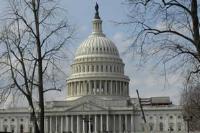
The system built to manage Russia’s nuclear legacy is crumbling, our new report shows
Our op-ed originally appeared in The Moscow Times. For more than three decades, Russia has been burdened with the remains of the Soviet ...
News

Publish date: January 29, 2008
Written by: Charles Digges
News
In fact, some of the money is going to hire Russians to work on a civilian nuclear power initiative that Congress has been reluctant to finance.
Some members of Congress said last week that the money might even be indirectly helping Russia supply Iran with nuclear technology, and that it might allow development in Russia of commercial products with which America would have to compete.
At a hearing of the investigations subcommittee of the House Energy and Commerce Committee, Representative John Dingell, Democrat of Michigan and chairman of the full committee, said that the Department of Energy (DOE) programme had begun with the best intentions but that there was “often a thin line between the noble and the naïve.”
The programme, which has a budget this year of $30 million, has spent about $309 million since its inception in 1994. It was considered a success in keeping newly impoverished scientists from emigrating to wealthy countries hostile to the United States that were seeking their weapons expertise.
But members of Congress have begun to worry that the programme may have outlived its usefulness as Russia’s circumstances have changed.
The revelations of the audit also cast an unfavourable light on a once successful non-proliferation agreement with Russia at a time when such programmes are getting negative attention or no attention,
Members of the subcommittee pointed out that Russia was awash in oil revenue. The senior Republican member, Representative John Shimkus of Illinois, said that the United States had bought $11 billion in oil and oil products from Russia from January 2005 through last October and that, unlike right after the collapse of the Soviet Union, Russia was now running budget surpluses.
“Clearly, Russia can afford to participate,” he told the hearing, according to a transcript.
According to the Government Accountability Office (GAO), while the programme’s goal was to prevent technologies for weapons of mass destruction from leaving the Soviet Union, an analysis of 97 projects employing 6,450 scientists from former Soviet states found that more than half of them “never claimed to have W.M.D. experience.” And nearly 1,000 of the scientists were born in 1970 or later. The Soviet Union was dissolved in December 1991.
DOE officials at the hearing quibbled with the specifics of the findings, saying that more than half were weapons scientists but that less than 60 percent fell in that category. They defended the programme by saying that all the scientists working under it were being kept from helping other countries with dangerous technologies.
Robert Robinson, a GAO official, said: “It feels a little bit like mission creep. When problem X is solved, we move the programme into problem Y, into infinity.”
The subcommittee chairman, Representative Bart Stupak, Democrat of Michigan, said the programme had become a “slush fund” for the DOE’s national laboratories, which are paid to oversee it.
Some of the money went to six research projects related to the DOE’s Global Nuclear Energy Partnership, a proposal that Congress has not embraced and that would recover plutonium and other materials from spent reactor fuel, for reuse in a new class of reactors.
DOE officials could not say if they were financing any scientists in Russian groups directly involved in supplying fuel to Iran. But a State Department official, Richard Stratford, acting deputy assistant secretary for nuclear non-proliferation policy, who was testifying about a programme run by his department to finance science centres in the former Soviet Union, said, “You could argue if you give Russia a dollar for whatever purpose, it frees up a dollar that can then be spent elsewhere.”
The State Department runs a programme similar to the one at the DOE. It is based on institutes, not individual scientists, but has “graduated” some of the institutes as they have become self-sufficient. The State Department hopes to end the programme by 2012. Several committee members called on the DOE to develop an “exit strategy.”

Our op-ed originally appeared in The Moscow Times. For more than three decades, Russia has been burdened with the remains of the Soviet ...

The United Nation’s COP30 global climate negotiations in Belém, Brazil ended this weekend with a watered-down resolution that failed to halt deforest...

For more than a week now — beginning September 23 — the Zaporizhzhia Nuclear Power Plant (ZNPP) has remained disconnected from Ukraine’s national pow...

Bellona has taken part in preparing the The World Nuclear Industry Status Report 2025 and will participate in the report’s global launch in Rome on September 22nd.